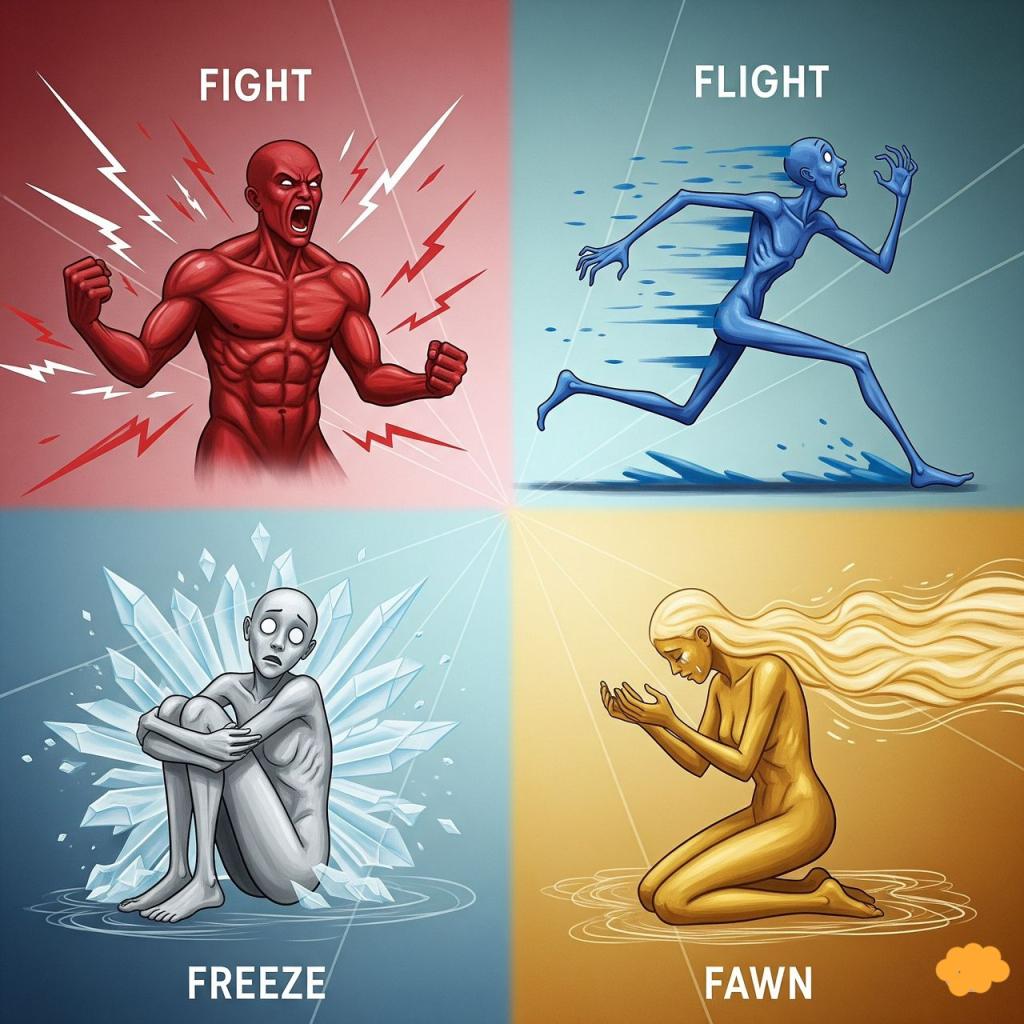How to Use Meditation to Build Mindfulness and Gratitude
Discover how to use meditation to cultivate mindfulness, gratitude, and emotional balance. Learn simple mindfulness techniques to reduce stress, improve focus, and live more intentionally.

Fight, flight, freeze, and fawn explained: Learn the 4 stress responses, what triggers them, and how to manage anxiety with grounding techniques.
By HealthBridge360.net Editorial Team
Medically Reviewed by Dr. [Insert Reviewer’s Name, MD]
Published August 2025 – Estimated Read Time: 4 min
Most people have heard of the “fight or flight” response, that surge of energy your body releases when it senses danger. It’s part of your nervous system’s survival wiring, designed to keep you alive in threatening situations.
But fight and flight aren’t the only survival strategies. Experts now recognize four primary stress responses: fight, flight, freeze, and fawn. Together, these describe the different ways the brain and body react when under extreme stress, fear, or trauma.
This built-in alarm system dates back to our ancestors facing wild animals or hostile environments. Today, even though the threats we face are often emotional or psychological, the body still reacts as if survival is at stake.
🧠 What Are Fight, Flight, Freeze, and Fawn?
These four responses come from the sympathetic nervous system, which instantly prepares the body to handle danger:
•Fight → Confront the threat head-on.
•Flight → Escape or run away from danger.
•Freeze → Shut down, unable to move or act.
•Fawn → Seek safety by appeasing others to reduce conflict.
The goal in each case is the same: to survive the perceived danger and eventually return to a calmer, safer state.
⚔️ The Fight Response
When your brain believes you can overcome a threat, your body enters fight mode. Stress hormones like adrenaline surge, preparing muscles and reflexes for action.
Common signs of fight mode:
•Clenched jaw or grinding teeth
•Intense anger or rage
•Urge to hit, punch, or lash out
•Stomping, kicking, or physical aggression
•Shaky, burning energy in your stomach
🏃 The Flight Response
If your system believes survival depends on escape, it triggers the urge to run. Adrenaline provides extra stamina to flee or avoid confrontation.
Signs of flight mode include:
•Restless body movements, pacing, fidgeting
•Darting eyes, scanning for exits
•Numbness in arms or legs
•Feeling trapped but desperate to move
•Over-exercising or compulsive activity
❄️ The Freeze Response
When neither fight nor flight seems possible, the body may shut down. This “play dead” response numbs sensations and temporarily halts action.
Freeze signs include:
•Pale skin or feeling cold/numb
•Heavy, stiff, or paralyzed body
•Loud, racing heartbeat or, in some cases, slowing pulse
•Sense of dread, detachment, or “zoning out”
🙏 The Fawn Response
Fawn is the least known but equally powerful. It occurs when a person tries to avoid danger by pleasing or appeasing others.
Often linked to childhood trauma or abusive environments, the fawn response teaches survival through compliance.
Signs of fawn mode include:
•Over-apologizing or over-agreeing
•Trying to keep everyone else happy
•Weak or nonexistent boundaries
•High sensitivity to others’ moods and needs
•Being easily manipulated or controlled
👉 Over time, fawning can lead to codependency and loss of personal identity.
🔬 What Happens Inside the Body During Stress?
Whether the stress is physical (like an accident) or psychological (like conflict), the process begins in the amygdala — the brain’s fear center.
•The amygdala signals the hypothalamus
•The hypothalamus activates the autonomic nervous system
•The adrenal glands release adrenaline and noradrenaline
This cascade increases heart rate, blood pressure, muscle readiness, and alertness — all designed to boost survival.
🧘 How to Manage the Stress Response
While the stress response protects us, it can become harmful if triggered too often, such as in anxiety disorders or PTSD. Chronic stress keeps the body on high alert, draining energy and increasing health risks.
Grounding Techniques That Help:
Mental:
•Focus on details in your environment
•Recite affirmations or calming phrases
•Play memory or alphabet games
Physical:
•Deep, steady breathing
•Press feet into the floor to “anchor” yourself
•Tense and release muscles slowly
Soothing:
•Visualize a safe place
•Speak gentle self-affirmations
•Engage in comforting activities
🌿 Final Word from HealthBridge360
Fight, flight, freeze, and fawn are natural, deeply human responses. They’re not signs of weakness but built-in survival strategies. Understanding them can help you recognize stress patterns in yourself or loved ones — and take steps toward healthier coping.
If your stress response interferes with daily life, consider speaking with a healthcare professional. Support through therapy, mindfulness, or medical care can restore balance.
Discover how to use meditation to cultivate mindfulness, gratitude, and emotional balance. Learn simple mindfulness techniques to reduce stress, improve focus, and live more intentionally.
Discover 9 affordable therapy options, from sliding-scale counseling to online support groups, and learn how to get mental health care on any budget
New research links poor sleep to 172 diseases, including dementia, Parkinson’s, and type 2 diabetes. Learn why sleep regularity matters more than duration.

